He held on and,in his sophomore year when he was 20,he met a young woman,Alyssa. She played basketball there,too,and grew up nearby. Alyssa is now his wife,and talks to me from Yvonne and Benny’s home in Queensland. “We started out as best friends and he’s still my best friend,” she says. “I feel like our relationship is the greatest love I’ve ever known.”
He needed her support. Drafted into the NBA by the Portland Trail Blazers,Mills spent two seasons riding the bench. Then,in 2011,the league was locked out for almost six months over a pay dispute,and Mills briefly played in Melbourne and China – a period plagued by self-doubt. No Shadows. No dance group. No college. Just agents and managers,injuries and struggles. “I needed to dig deeper,but you’re hanging in limbo,” he recalls. “It’s that brutal,lonely part of being a professional athlete,which not everyone sees.”
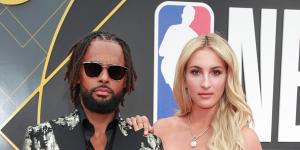
With wife Alyssa,who also played US college basketball.Credit:Getty Images
He returned to the US in early 2012 to join the San Antonio Spurs,in many ways a vaunted exemplar of consistent,collective success. Their inclusive values matched his own,and he became a beloved “locker room guy”,but still,he wasn’t playing to the level of future NBA Hall of Famers like Tim Duncan and Tony Parker. His position on court – point guard – means seeing the floor and finding the right spaces and angles within that incalculable fluid geometry. But initially Mills couldn’t be trusted to play with enough savvy,too often turning the ball over or letting it fly. He needed better fitness,too. His coach,Gregg Popovich,noticed “too much junk in the trunk”.
He never shared that opinion with “Fatty Patty”,but Mills knew. “Every Spur has this moment with Pop,” Mills says. “You’ve gotta find where you sit in his whole system.” He had to do something extreme,so he halved his body fat and shaved his beard and head. “That helped create this impression – for me and for everyone else – that this was a different dude. One of my mottos at that time was,‘Earn the right’.”
Mills thus evolved into a player whose pace and canny can change the complexion of any game,whether drawing a forest of much taller opponents (he is 183 centimetres or six feet tall,incredibly short for the NBA) before dishing to a teammate in a better position,or by attacking alone – throwing up a shot that travels on some seemingly predestined 10-metre gravitational arc,dropping like falling water into a circle only slightly larger than the ball itself.
“He’s never been a high-volume,high-minutes guy. He plays a role,and that’s why he survives. He’s not out there on an ego trip making the game about himself.”
Basically,he shoots well (the frigate bird),is among the fastest players in the league (the Spanish mackerel),and uses that speed with cerebral intent (the wedge-tailed eagle) to benefit all (the green turtle). “He’s never been a high-volume,high-minutes guy,” says Gaze. “He plays a role,and that’s why he survives. He’s not out there on an ego trip making the game about himself. His ability is to make those around him better.”
That,too,taps deeply into the San Antonio ethos,best encapsulated by 19th-century Danish-American social reformer Jacob Riis’sThe Stonecutter’s Credo:When nothing seems to help,I go and look at a stonecutter hammering away at his rock perhaps a hundred times without as much as a crack showing in it. Yet at the hundred and first blow it will split in two,and I know it was not that blow that did it – but all that had gone before. The locker room is festooned with that phrase,in the language of every player – including Meriam Mer. Mills’s relatives did the translation.
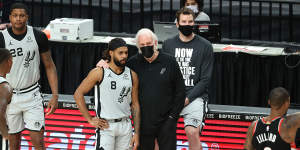
Mills with Gregg Popovich at an NBA game earlier this year. The San Antonio Spurs coach once talked about Eddie Mabo to inspire his players.Credit:Getty Images
Popovich is famous for harnessing his players’ histories in such ways,but Mills was still shocked by what happened the day before game one of the 2014 NBA Finals. The Spurs had lost in 2013,and this was their chance to atone. “It’s day one. Switch on. Prepare. Activate. Miami Heat. LeBron James. Dwayne Wade,” he said. “You can throw any question at me and I’ve got the answer in the chamber,ready to fire.”
Popovich stood at the front of the tiered video room:“Does anyone know what day it is today?”
Mills said nothing. Surely he couldn’t be talking about Mabo Day? Then a black-and-white photo of his great-uncle,Eddie Mabo himself,appeared on screen. “And I just remember leaning back in my chair,” says Mills. “Rock in my throat.”
Popovich launched into an impassioned description of the land rights campaigner. He offered no inspirational message or tactical tangent,and made no connection to Mills,other than asking if there was anything he wanted to add. “But I didn’t,because he nailed it.”
It’s easy to see how,in this environment,Mills found his voice. His foreign accent began prompting questions about his culture,and at first he didn’t know what to say. “Now,if someone is curious and they ask,‘Where are you from,mate?’ they really don’t know what they’re walking into,” he says,rubbing his hands together,“because we’re gonna dive into this thing,and it might be next week by the time we get out of here.”
This seems a good moment to talk about George Floyd,murdered in Minneapolis last year,and what that stirred inside Mills. He silently summons his thoughts,grateful for the opportunity – whispering,“I love it,I love it” – as the recollections roll around.
“This is what I’ll say,” he declares,finally. “I was more shocked at the reaction than the act itself. I remember thinking,‘Why is this one making you people realise this stuff? Is it because of the camera? His voice?’ And people are calling me and saying,‘I see now!’ and there’s me wondering why they haven’t seen for years and years.”
When Black Lives Matter protests began raging in Australia soon after,and Prime Minister Scott Morrison admonished people for “importing” social causes from abroad,or went on radio to claim “there was no slavery in Australia” – despite the well-documented practice of “blackbirding” (trafficking Pacific Islanders into indentured labour) – Mills needed to be heard.
“Leaders of Australia – We can do better,” hewrote on Twitter. Start by educating yourselves on black deaths in custody. “It doesn’t need to be ‘imported’ because this behaviour has already existed in our own backyard for decades.”
“Nor do I see any of the things I do as political activism. It’s just what my family have always done. It’s living culture.”
The #PattyForPM hashtag was born,but does he have any interest in politics? “I don’t,” he answers,flatly. “Nor do I see any of the things I do as political activism. It’s just what my family have always done. It’s living culture.”
This reminds me of a phrase in the Torres Strait. When you speak,you’re “throwing words” into the air for your ancestors. Mills nods. “If there’s something I believe is right,I back myself,” he says. “We’re not America. We are our own country,and we have our own issues. Progress has been made,but we’ve got so far to go.”
Loading
He walks that talk,too. When the Black Summer bushfires razed our landscape,Mills used the NBA All-Star break to map a trip with Alyssa through southern NSW,dropping supplies in Mogo and Cobargo and beyond. When he returned to Texas,he ran a Mother’s Day coffee drive (#givemamacoffee),raising more than $US100,000 for a local battered women’s and children’s shelter. As the pandemic took hold,he sank time and money into creating Indigenous Basketball Australia,a non-profit pathway program run by his parents. He also establishedKeriba Ged,a partnership taking Indigenous teens to the US to learn business and hospitality skills in an Australian cafe chain.
Finally,in the middle of 2020,when the NBA season restarted and teams entered a bubble in Orlando,Mills announced that he would tip all his earnings from those eight games,$US1,017,818.54,directly into Black Lives Matter Australia,Black Deaths in Custody and We Got You,a campaign to end racism in Australian sport.
In the midst of the pandemic pause,while we made sourdough or learnt an instrument,Mills went full philanthropist. “I couldn’t play basketball,so” – he smacks his hands togetherclap,clap,clap – “let’s get to work. Now’s the time. That’s the silver lining:doing the work.”
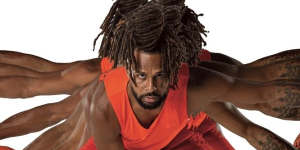
“If there’s something I believe is right,I back myself. We’re not America. We are our own country,and we have our own issues. Progress has been made,but we’ve got so far to go.”Credit:Paul Harris
It was dark in the tunnel in Tokyo. As Patty Mills waited to enter the opening ceremony withfellow Olympic flag bearer Cate Campbell,she turned to him –How cool would a heaving grandstand have been? – yet what he felt was the complete opposite.
“I’m getting hairs standing up just talking about it,” Mills says. “What I could feel looking into that empty stadium – which was so heavy and so deep – was a presence. And it was loud. I could feel a whole country.” It was the same eerie electric hum he felt on his last visit to Uluru,with the Boomers before the 2016 Rio Olympics. “In the red heart,you reconnect with what it all means. You feel things. A greater presence. That’s what I felt.”
Of all the passions Mills fosters,few mean more to him than the Boomers. Immediately before our second quarantine chat,he was sitting down,feet up,sipping coffee,listening to Yothu Yindi and poring over the roster of former Boomers. He was about to honour those players at an event in Brisbane,including his uncle,Danny Morseu,who played in the 1980 and 1984 Olympics,and his cousin,Nathan “Outback Shaq” Jawai,the first Indigenous Australian in the NBA.
Mills is an Olympics watcher,always has been. He was 12 when he watched Cathy Freeman win gold in Sydney. “It was the becoming of me,” he says,“and understanding my identity.” He first played for the Boomers – and under Goorjian – at the 2008 Olympics in Beijing. Andrew Gaze and Luc Longley had only recently retired and Mills,19,represented the changing of the guard. “The culture needed to be rebuilt,” says Goorjian. “I walked back in the door 12 years later and was absolutely gobsmacked by how far it had come.”
Focused on Tokyo,Mills helped establish a training centre in Newport Beach,California – a gym with the Aboriginal flag,Torres Strait Island flag and Australian flag draped on both sides of the arena. At centre court was a music box playing Cold Chisel,Kylie Minogue and AC/DC. One night he rented a luxury bus to take the squad to a huge house in the canyons outside Los Angeles. They spent the night by the pool,with food trucks and a band. Everyone got an Akubra and a bum bag with Vegemite and Milo.
Mills drove standards,too,living his famous “gold vibes only” motto by example. His training routines – down to every last dribble,fake and shot – were a choreographed dance. “I’ve been in basketball a long time but that organisation,I’ve seen nothing to this level,” Goorjian remembers. “Patty’s mantra was,‘No surprises’. Everything was just … intentional.”
In Japan,their locker room was sacred. An Indigenous man,Albert “Junior” Viranatuleo,the team manager,made sure everything was washed and hung,slogans on walls,with razors,towels,food,flags and music. “You could see the other teams walk by and marvel,” says Goorjian. “It was like that line from Butch Cassidy and the Sundance Kid:‘Who are those guys?’ ”
It led,of course,to that famous bronze medal,the first for the Boomers,and Mills was sheer luminescence. Australia rejoiced largely from couches in winter lockdown,none louder or prouder than the Indigenous community. Shelley Ware,a Yankunytjatjara and Wirangu woman and sports presenter,wept. “The whole Aboriginal community was just sobbing,” she says. “My 14-year-old son went off to bed wearing his Mills jersey.”
Yet the speech Mills gave afterward is what stays with her,when he again acknowledged all bygone Boomers:from the legendary Lindsay Gaze to Michael Ah Matt,the first Indigenous player to represent this country in 1964. “That’s the beauty that’s often missed in reflections on Indigenous people:the deep connection to our ancestors and the people who have walked before us,” Ware says. “Every step forward is because of them.”
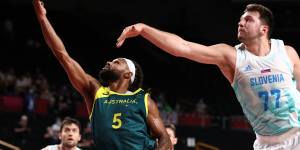
Mills played a key role in the Boomers’ best-ever Olympics result.Credit:Getty Images
It’s easy to see why Patty Mills is beloved in San Antonio,why he was once called their “spiritual leader”. Yet Mills is leaving Texas,after almost 10 years,for New York and the Brooklyn Nets. He’s there right now,gearing up to play for what is colloquially and accurately known as a “super team”. Welcome to the new NBA era of player empowerment,in which marquee names decide where they’ll play,and with whom.
To be clear,Mills is not one of those names. If he is a star in the basketball universe,his new teammates Kevin Durant,Kyrie Irving and James Harden are unfathomable celestial bodies,supernovas as much as superstars. In many ways,Mills’s job at the Nets will be to bind their galactic genius. He sees his role as it has always been:driving internal culture,locker-room levity,and using his new prime-time platform for social change.
For a figure so invested in the Spurs identity I’ve got to ask,why leave? “I haven’t been in the frame of mind to be able to answer this question,” he says,“but I’ll get there now because it’s important.” He stumbles a little through his reasons,but the key ones are all there. First,he saw Spurs sprinkled throughout the Brooklyn organisation. “It’s the modern-day San Antonio,if you like.” Next,he’s offered a chance to play a larger part for an immediate title contender in an NBA championship – for his star to become a planet or comet,maybe the moon.
“It’s humbling,” he says. “There’s a feeling of opportunity:to be able to be me,and fulfil a role that is true to who I am.”
He’s on a $US12 million ($16.6 million),two-year contract. I’m curious if the money (in 2017 he signed a $US50 million,four-year contract) has ever got the better of him. Choosing Brooklyn,he says,answers that question.
Because he could have made more elsewhere,instead of chasing success? “How do I say that without saying that?” he says,laughing. “I definitely attempted it!”
Loading
He’s not one to flaunt his wealth,anyway. I ask what he drives,knowing that Durant (Chevrolet Camaro SS),Harden (Rolls-Royce Wraith) and Irving (Lamborghini Aventador) have ostentatious favourites within lavish car collections. Mills? He drives a Volkswagen Golf. Has done for 10 years.
He does own a slice of tropical paradise:a getaway waterfront acre on the north shore of Oahu,fringed by palms. It cost $US1.92 million. “People might hear Hawaii and think indulgence,but let’s start peeling back the layers,” he says. “It gave me a connection to home,to the water,to the culture of Oceania. I get my three-pronged spear and go down into the water,get my fish,clean it,gut it,chuck it on the fire.”
Arrive at the Mills compound and you’re likely to find him up a banana tree with a machete,chopping leaves so Alyssa can wrap dough for damper. They “practise culture” together daily,through food and music and art. When the NBA schedule is hectic,Alyssa goes alone to the Torres Strait,to improve her dancing and fish for coral trout and see all the aunties.
“I personally feel like this culture is a part of who I am and who we are,” she says. The value of a big contract – to both of them – is the freedom it buys,and the change it can affect. “We want to leave a lasting impression. It’s all about impact.”
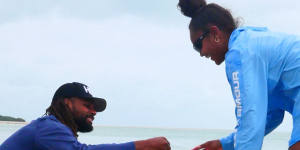
Mills with his niece,Miia,cleaning fish at Thursday Island.Credit:Courtesy of Patty Mills
As I enter the fourth hour of talking to Patty Mills,he sits this final time in front of a fan-mail collage on the hotel-room wall. Almost every kid’s letter sent to him includes a Crayola or Texta scribble of the Aboriginal and Torres Strait Islands flags,and Mills is so touched he gets tearful. He’s also emotional because he’s (almost) home for the first time in 18 months. “My life is going from journey to journey,mate,” he says. “I can’t wait to see my family. I can’t wait to feel the ocean and touch the sand and jump in the red dirt.”
I can’t help but look at him now and think back to his beginnings,all those songlines and totems,the dispossession and deaths in custody,the Stolen Generations and the Native Title Act,and all he’s done since,and how it feels as though Mills was meant to be. Meant to be the next icon for Indigenous Australia. But is he ready? Does he even want that? “Wait,” he replies. “Do you think I’m an icon for Indigenous Australians only?”

Mills and Joe Ingles after winning the men’s basketball bronze medal.Credit:AP
I don’t. There is clearly something different in his ascension,in the way he’s been received as a bridge between black and white. There’s a long list of Indigenous athletes whom we’ve fêted madly yet failed badly,from Johnny Mullagh to Adam Goodes. Each episode is like a pencil line drawn on a wall,tracking the height of an ignorant child. But hopefully more lines are edging higher,marking our growing cultural fluency. Remember that photo after the medal match:of bigJoe Ingles,pale and balding,hugging little Patty Mills,dark and dreadlocked?
“No one can lay a finger on him. It’s almost like,if you’re gonna box on with Patty,you’ve gotta box on with us,too.”
“That image is a moment,like Peter Norman or Cathy Freeman,” says Murran and Bunitj woman Nova Peris,the politician and former athlete. “It was like Patty was playing for something greater. For reconciliation.” Peris suspects this is partly why Mills has avoided toxic whitelash in his career so far. “No one can lay a finger on him,” she says. “It’s almost like,if you’re gonna box on with Patty,you’ve gotta box on with us,too.”
Loading
I offer that thesis to Mills – that his moment transcended sport – that the way we respond to him is a reflection of us and how we might be learning. “Well,when you’re tapping that around on the page,let me guide you,” Mills says,palms together. “I’ve always been about building this unifying thing. And maybe,for me,basketball is a way of softly bringing down all these barriers,that careful way of getting to the place we all want to be.”
We don’t need to create anything new. We just need to value that which already exists and persists. We need to pay attention. The wind is shifting. The rains are coming. The signs are there.
“I don’t know the answers. I just know how to go about life,and if that’s in the right direction,then let’s empower that. This is all our culture:something we all can celebrate and enjoy. It’s like,this is working. Write that,” Mills says,beaming. “Tap away. Go. Put ball in basket.”
To read more from Good Weekendmagazine,visit our page atThe Sydney Morning Herald,The Age andBrisbane Times.
The best of Good Weekend delivered to your inbox every Saturday morning.Sign up here.